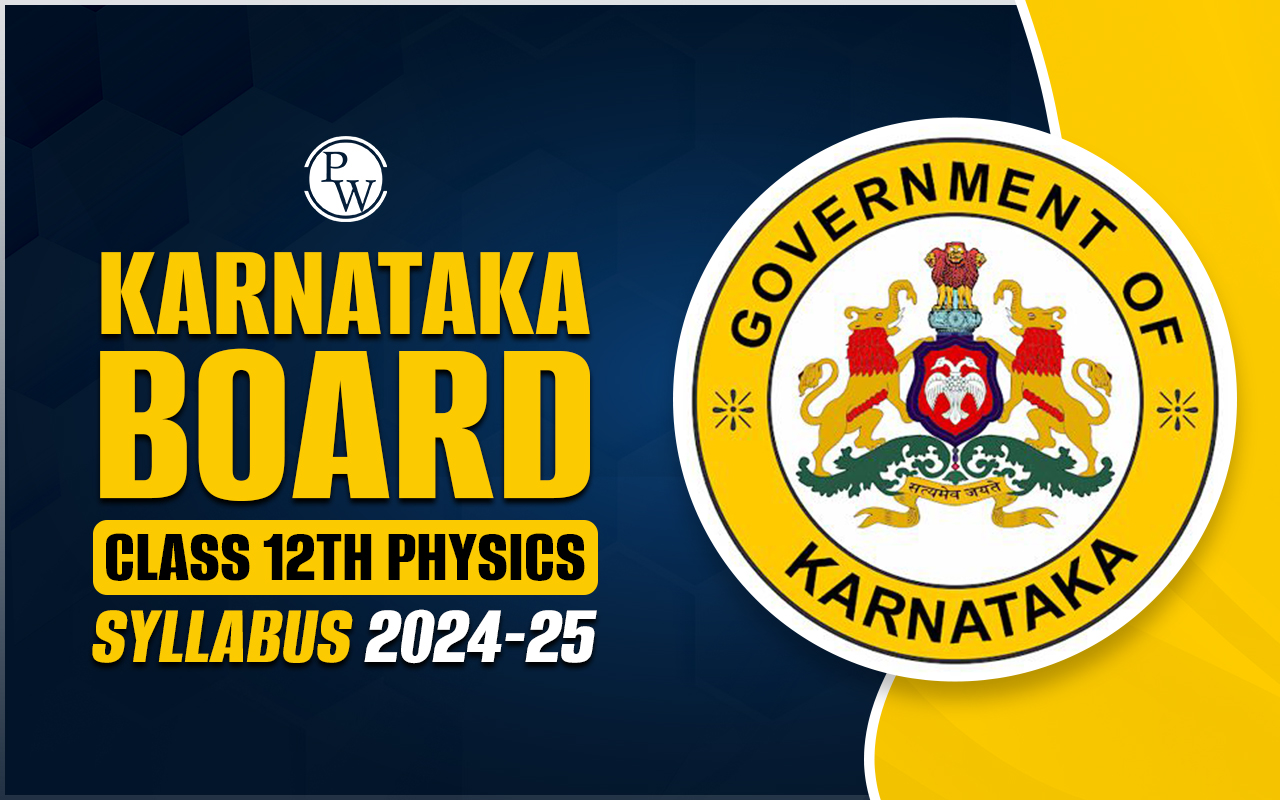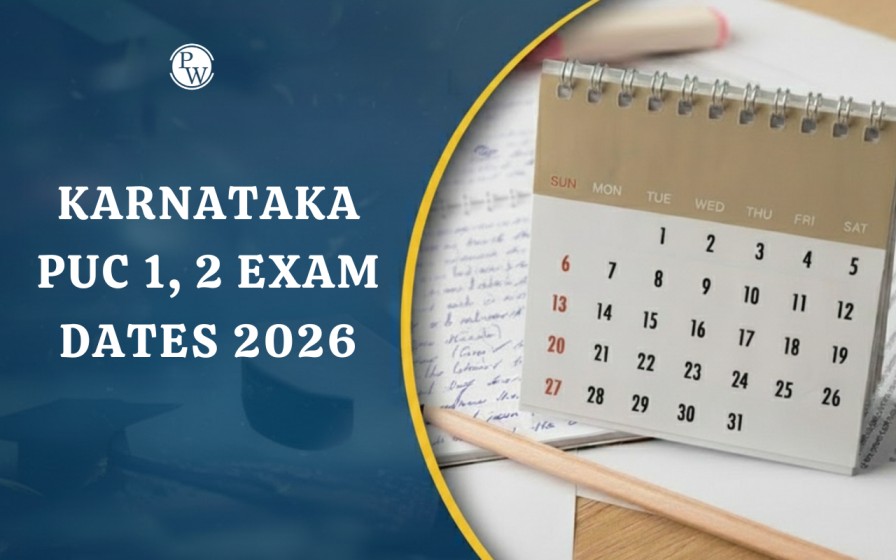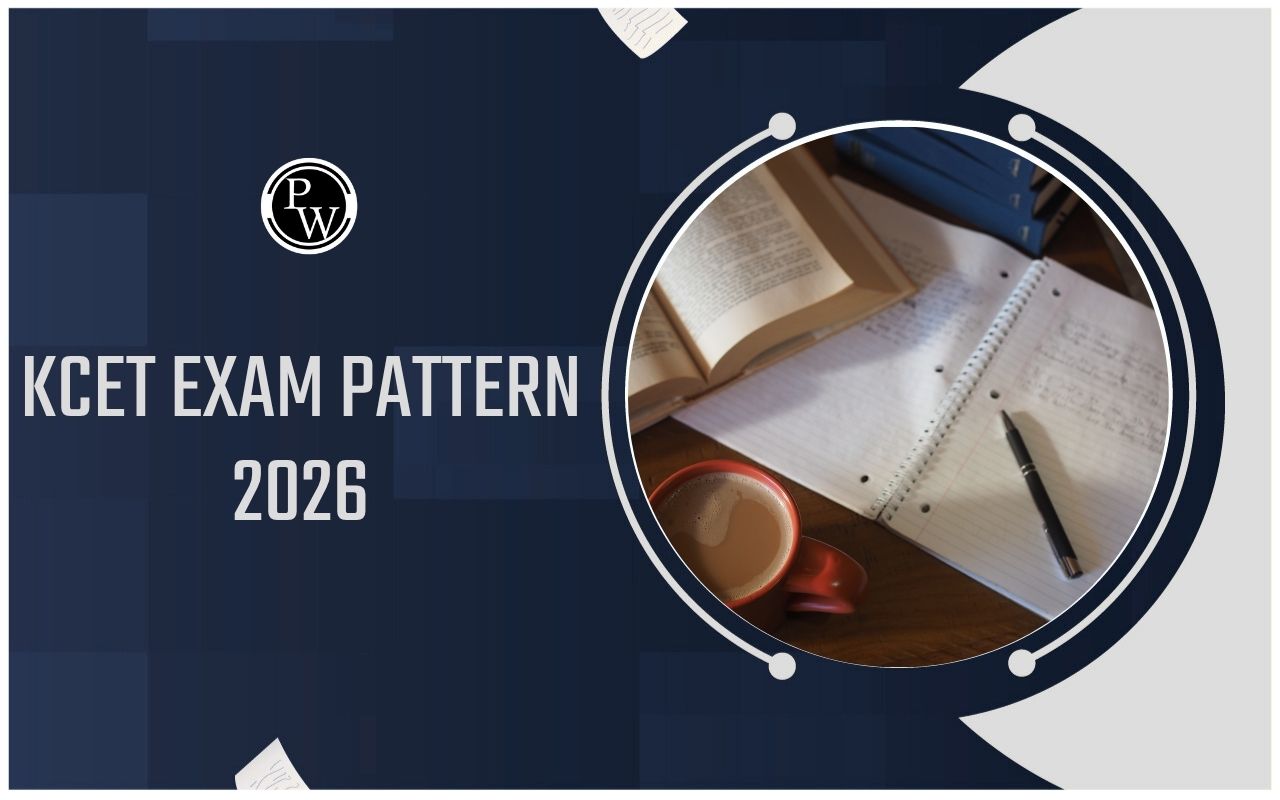

Karnataka Board Class 12th Physics Syllabus 2024-25 outlines all the important topics students need to cover for the upcoming Karnataka Board Class 12th . Understanding the syllabus is essential for proper preparation as it provides detailed insights into the key concepts, practicals, and theoretical portions.
The syllabus includes chapters like Electric Charges, Magnetism, and Optics, ensuring a comprehensive coverage of all major areas in physics. Students are advised to review the syllabus thoroughly to plan their studies effectively. You can download the complete syllabus for better preparation using the link in this article.Karnataka Board Class 12th Physics Syllabus 2024-25
The Karnataka Board Class 12th Physics Syllabus 2024-25 covers a wide range of topics, ensuring students are well-prepared for their exams. The syllabus includes both theoretical concepts and practical applications. The details are mentioned below, however, the students can check the full Karnataka Board Class 12th syllabus here| Karnataka Board Class 12th Physics Syllabus 2024-25 | |
|---|---|
| Part I | Topics |
| Chapter 1: Electric Charges and Fields | 1.1 Introduction |
| 1.5 Basic Properties of Electric Charge | |
| 1.6 Coulomb’s Law | |
| 1.7 Forces Between Multiple Charges | |
| 1.8 Electric Field | |
| 1.9 Electric Field Lines | |
| 1.10 Electric Flux | |
| 1.11 Electric Dipole | |
| 1.12 Dipole in a Uniform External Field | |
| 1.13 Continuous Charge Distribution | |
| 1.14 Gauss’s Law | |
| 1.15 Applications of Gauss’s Law | |
| Chapter 2: Electrostatic Potential and Capacitance | 2.1 Introduction |
| 2.2 Electrostatic Potential | |
| 2.3 Potential Due to a Point Charge | |
| 2.4 Potential Due to an Electric Dipole | |
| 2.5 Potential Due to a System of Charges | |
| 2.6 Equipotential Surfaces | |
| 2.7 Potential Energy of a System of Charges | |
| 2.8 Potential Energy in an External Field | |
| 2.9 Electrostatics of Conductors | |
| 2.10 Dielectrics and Polarisation | |
| 2.11 Capacitors and Capacitance | |
| 2.12 The Parallel Plate Capacitor | |
| 2.13 Effect of Dielectric on Capacitance | |
| 2.14 Combination of Capacitors | |
| Chapter 3: Current Electricity | 3.1 Introduction |
| 3.2 Electric Current | |
| 3.3 Electric Currents in Conductors | |
| 3.4 Ohm’s Law | |
| 3.5 Drift of Electrons and the Origin of Resistivity | |
| 3.6 Limitations of Ohm’s Law | |
| 3.8 Temperature Dependence of Resistivity | |
| 3.9 Electrical Energy, Power | |
| 3.11 Cells, emf, Internal Resistance | |
| 3.12 Cells in Series and Parallel | |
| 3.13 Kirchhoff’s Rules | |
| 3.14 Wheatstone Bridge | |
| Chapter 4: Moving Charges and Magnetism | 4.1 Introduction |
| 4.2 Magnetic Force | |
| 4.3 Motion in a Magnetic Field | |
| 4.4 Motion in Combined Electric and Magnetic Fields | |
| 4.5 Magnetic Field due to a Current Element, Biot-Savart Law | |
| 4.6 Magnetic Field on the Axis of a Circular Current Loop | |
| 4.7 Ampere’s Circuital Law | |
| 4.8 The Solenoid and the Toroid | |
| 4.9 Force Between Two Parallel Currents, The Ampere | |
| 4.10 Torque on Current Loop, Magnetic Dipole | |
| 4.11 The Moving Coil Galvanometer | |
| Chapter 5: Magnetism and Matter | 5.1 Introduction |
| 5.2 The Bar Magnet | |
| 5.2.1 The Magnetic Field Lines | |
| 5.3 Magnetism and Gauss's Law | |
| 5.4 The Earth’s Magnetism | |
| 5.5 Magnetisation and Magnetic Intensity | |
| Chapter 6: Electromagnetic Induction | 6.1 Introduction |
| 6.2 The Experiments of Faraday and Henry | |
| 6.3 Magnetic Flux | |
| 6.4 Faraday’s Law of Induction | |
| 6.5 Lenz’s Law and Conservation of Energy | |
| 6.6 Motional Electromotive Force | |
| 6.9 Inductance | |
| 6.10 AC Generator | |
| Chapter 7: Alternating Current | 7.1 Introduction |
| 7.2 AC Voltage Applied to a Resistor | |
| 7.3 Representation of AC Current and Voltage by Rotating Vectors—Phasors | |
| 7.4 AC Voltage Applied to an Inductor | |
| 7.5 AC Voltage Applied to a Capacitor | |
| 7.6 AC Voltage Applied to a Series LCR Circuit | |
| 7.9 Transformers | |
| Chapter 8: Electromagnetic Waves | 8.1 Introduction |
| 8.3 Electromagnetic Waves | |
| 8.4 Electromagnetic Spectrum | |
| Part II | |
| Chapter 9: Ray Optics and Optical Instruments | 9.1 Introduction |
| 9.4 Total Internal Reflection | |
| 9.5 Refraction at Spherical Surfaces and by Lenses | |
| 9.6 Refraction through a Prism | |
| 9.8 Optical Instruments (except resolving power microscope and astronomical telescope) | |
| Chapter 10: Wave Optics | 10.1 Introduction |
| 10.2 Huygens Principle | |
| 10.3 Refraction and Reflection of Plane Waves Using Huygens Principle | |
| 10.4 Coherent and Incoherent Addition of Waves | |
| Chapter 11: Dual Nature of Radiation and Matter | 11.1 Introduction |
| 11.2 Electron Emission | |
| 11.3 Photoelectric Effect | |
| 11.4 Experimental Study of Photoelectric Effect | |
| 11.5 Photoelectric Effect and Wave Theory of Light | |
| 11.6 Einstein’s Photoelectric Equation: Energy Quantum of Radiation | |
| 11.7 Particle Nature of Light: The Photon | |
| 11.8 Wave Nature of Matter | |
| Chapter 12: Atoms | 12.1 Introduction Experiment |
| 12.2 Alpha Particle Scattering and Rutherford’s Nuclear Model of Atom | |
| 12.3 Atomic Spectra | |
| 12.6 De Broglie’s Explanation of Bohr’s Second Postulate of Quantisation | |
| Chapter 13: Nuclei | 13.1 Introduction |
| 13.2 Atomic Masses and Composition of Nucleus | |
| 13.3 Size of the Nucleus | |
| 13.4 Mass Energy and Nuclear Binding Energy (except binding energy per nucleon and its variation with the mass number) | |
| 13.5 Nuclear Force | |
| 13.7 Nuclear Energy | |
| Chapter 14: Semiconductor Electronics: Material Devices and Simple Circuits | 14.1 Introduction |
| 14.2 Classification of Metals, Conductors and Semiconductors | |
| 14.3 Intrinsic Semiconductor | |
| 14.4 Extrinsic Semiconductor | |
Karnataka Board Class 12th Physics Syllabus 2024-25 Deleted Topics
The deleted topics for the Karnataka Board Class 12th Physics Syllabus 2024-25 outline the areas that have been removed for the current academic year, reducing the overall syllabus load for students. The details are mentioned below.| Karnataka Board Class 12th Physics Syllabus 2024-25 Deleted Topics | |
|---|---|
| Chapter | Deleted Topics |
| Part I | |
| Chapter 1: Electric Charges and Fields | 1.2 Electric Charge (delete only activity with paper strips and making) |
| 1.3 Conductors and Insulators (delete only) | |
| 1.4 Charging by Induction Exercises | |
| 1.13, 1.25–1.34 | |
| Chapter 2: Electrostatic Potential and Capacitance | 2.15 Energy Stored in a Capacitor (delete only derivation) |
| Exercises 2.12 to 2.36 | |
| Chapter 3: Current Electricity | 3.7 Resistivity of Various Materials (delete tables) |
| 3.1 and 3.2 Carbon resistors, Colour code for carbon resistor | |
| 3.10 Combinations of Resistors – Series and Parallel Example 3.5 | |
| 3.15 Meter Bridge | |
| 3.16 Potentiometer | |
| Exercises 3.3, 3.4, 3.10, 3.12, 3.14–3.23 | |
| Chapter 4: Moving Charges and Magnetism | Table 4.1 |
| 4.4.1 Velocity Selector | |
| 4.4.2 Cyclotron | |
| 4.8 The Toroid | |
| 4.10.3 The Magnetic Dipole Moment of a Revolving Electron | |
| Exercises 4.14–4.28 | |
| Chapter 5: Magnetism and Matter | 5.2.2 Bar Magnet as an Equivalent Solenoid (delete only mathematical treatment) |
| 5.2.3 The Dipole in a Uniform Magnetic Field (delete only mathematical treatment) | |
| 5.4 Earth's Magnetism | |
| 5.4.1 Magnetic Declination and Dip | |
| Table 5.2 | |
| 5.6.2 Paramagnetism | |
| 5.6.3 Ferromagnetism temperature and Hysteresis | |
| 5.7 Permanent Magnets and Electromagnets | |
| Exercises 5.1, 5.2, 5.9–5.11, 5.13–5.25 | |
| Chapter 6: Electromagnetic Induction | 6.7 Energy Consideration: A Quantitative Study |
| 6.8 Eddy Currents | |
| Exercises 6.6, 6.10–6.17 | |
| Chapter 7: Alternating Current | Figure 7.7 Magnetisation and Demagnetisation of an Inductor |
| Figure 7.10 Charging and Discharging of a Capacitor | |
| 7.6.2 Analytical Solution | |
| 7.6.3 Resonance (delete only sharpness of resonance) | |
| 7.8 LC Oscillations | |
| Exercises 7.6, 7.8, 7.10, 7.12–7.26 | |
| Chapter 8: Electromagnetic Waves | Example 8.1 |
| 8.3.2 Nature of Electromagnetic Waves (delete only about ether and page 277) | |
| Examples 8.4 and 8.5 | |
| Exercises 8.11–8.15 | |
| Part II | |
| Chapter 9: Ray Optics and Optical Instruments | 9.3 Refraction (delete only advanced sunrise and delayed sunset) |
| 9.7 Some Natural Phenomena Due to Sunlight | |
| 9.7.1 The Rainbow | |
| 9.7.2 Scattering of Light Exercise 9.18 | |
| Chapter 10: Wave Optics | 10.3.4 Doppler Effect |
| Example 10.1 | |
| 10.5 Interference of Light waves and Young's experiment (retain the final expressions for dark and bright fringes but delete the derivation), delete expression for fringe width | |
| 10.6 Diffraction (retain only qualitative treatment) | |
| 10.3 Resolving Power of Optical Instruments | |
| 10.6.4 Validity of Ray Optics | |
| 10.7.1 Polarisation by Scattering | |
| 10.7.2 Polarisation by Exercises 10.7–10.21 | |
| Chapter 11: Dual Nature of Radiation and Matter | Table 11.1 |
| Example 11.3 | |
| 11.8 Wave Nature of Matter (delete only derivation for de Broglie wavelength of accelerated electron; and Heisenberg’s uncertainty principle) | |
| 11.9 Davisson and Germer Experiment | |
| Appendix 11.1 The History of Wave-Particle Flip-Flop | |
| Exercises 11.5, 11.7, 11.12 to 11.14, 11.16, 11.17, 11.19–11.37 | |
| Chapter 12: Atoms | 12.3.1 Spectral Series |
| 12.4 Bohr Model of the Hydrogen Atom (retain only the expression for radius of nth possible orbit but delete its derivative) | |
| 12.5 The Line Spectra of the Hydrogen Atom (retain only qualitative treatment) | |
| Example 12.6 | |
| Exercises 12.3, 12.11–12.17 | |
| Chapter 13: Nuclei | 13.6.1 Law of Radioactive Decay |
| 13.6.2 Alpha Decay | |
| 13.6.3 Beta Decay | |
| 13.6.4 Gamma Decay | |
| 13.7 Nuclear Reactor | |
| Exercises 13.1, 13.2, 13.6–13.10, 13.12–13.14, 13.18, 13.22–13.31 | |
| Chapter 14: Semiconductor Electronics: Material Devices and Simple Circuits | 14.8 Special Purpose p-n Junction Diodes |
| 14.9 Digital Electronics and Logic Gates | |
| Exercises 14.7–14.15 | |
Karnataka Board Class 12th Physics Syllabus 2024-25 PDF Download
The Karnataka Board Class 12th Physics Syllabus 2024-25 PDF provides an in-depth understanding of the key topics and chapters that students need to prepare. Accessing the syllabus will help you align your studies, understand the weightage of each unit, and improve time management. Downloading the PDF allows you to have a structured guide that you can refer to anytime. The download link is provided below for easy access.Karnataka Board Class 12th Physics Syllabus 2024-25 PDF Download
Karnataka Board Class 12th Physics Syllabus 2024-25 Weightage Marks
The weightage marks for Karnataka Board Class 12th Physics Syllabus 2024-25 highlight the importance of each unit, allowing students to focus on the sections that carry higher marks in the final exam. The details are mentioned below.| Karnataka Board Class 12th Physics Syllabus 2024-25 Weightage Marks | ||
|---|---|---|
| Unit Number | Chapter Name | Total Marks |
| Unit 1 | Electric Charges & Fields | 11 marks |
| Unit 2 | Electrostatic Potential and Capacitance | 11 marks |
| Unit 3 | Current Electricity | 14 marks |
| Unit 4 | Moving Charges and Magnetism | 12 marks |
| Unit 5 | Magnetism and Matter | 6 marks |
| Unit 6 | Electromagnetic Induction | 8 marks |
| Unit 7 | Alternating Current | 8 marks |
| Unit 8 | Electromagnetic Waves | 3 marks |
| Unit 9 | Ray Optics and Optical Instruments | 11 marks |
| Unit 10 | Wave Optics | 7 marks |
| Unit 11 | Dual Nature of Radiation and Matter | 6 marks |
| Unit 12 | Atoms | 4 marks |
| Unit 13 | Nuclei | 5 marks |
| Unit 14 | Semiconductor Electronics | 9 marks |
Karnataka Board Class 12th Physics Syllabus 2024-25 FAQs
What are the key topics in the Karnataka Board Class 12th Physics Syllabus 2024-25?
The syllabus covers topics such as Electric Charges and Fields, Magnetism, Optics, and Electromagnetic Waves, among others. These topics are designed to provide a comprehensive understanding of core physics concepts.
Are there any changes or deletions in the Karnataka Board Class 12th Physics Syllabus 2024-25?
Yes, certain topics have been deleted to reduce the syllabus load. These deletions help students focus on essential concepts. Check the updated syllabus for detailed information on deleted topics.
How many marks are assigned to each unit in the Karnataka Board Class 12th Physics exam?
The marks for each unit vary. Units like Current Electricity and Optics carry more weightage, helping students prioritize their preparation. Detailed weightage marks are mentioned in the syllabus.
Where can I download the Karnataka Board Class 12th Physics Syllabus 2024-25 PDF?
The syllabus is available for download on the official Karnataka Board website. It provides students with a clear structure of the exam content and helps them plan their studies effectively.
Talk to a counsellorHave doubts? Our support team will be happy to assist you!

Check out these Related Articles
Free Learning Resources
PW Books
Notes (Class 10-12)
PW Study Materials
Notes (Class 6-9)
Ncert Solutions
Govt Exams
Class 6th to 12th Online Courses
Govt Job Exams Courses
UPSC Coaching
Defence Exam Coaching
Gate Exam Coaching
Other Exams
Know about Physics Wallah
Physics Wallah is an Indian edtech platform that provides accessible & comprehensive learning experiences to students from Class 6th to postgraduate level. We also provide extensive NCERT solutions, sample paper, NEET, JEE Mains, BITSAT previous year papers & more such resources to students. Physics Wallah also caters to over 3.5 million registered students and over 78 lakh+ Youtube subscribers with 4.8 rating on its app.
We Stand Out because
We provide students with intensive courses with India’s qualified & experienced faculties & mentors. PW strives to make the learning experience comprehensive and accessible for students of all sections of society. We believe in empowering every single student who couldn't dream of a good career in engineering and medical field earlier.
Our Key Focus Areas
Physics Wallah's main focus is to make the learning experience as economical as possible for all students. With our affordable courses like Lakshya, Udaan and Arjuna and many others, we have been able to provide a platform for lakhs of aspirants. From providing Chemistry, Maths, Physics formula to giving e-books of eminent authors like RD Sharma, RS Aggarwal and Lakhmir Singh, PW focuses on every single student's need for preparation.
What Makes Us Different
Physics Wallah strives to develop a comprehensive pedagogical structure for students, where they get a state-of-the-art learning experience with study material and resources. Apart from catering students preparing for JEE Mains and NEET, PW also provides study material for each state board like Uttar Pradesh, Bihar, and others
Copyright © 2025 Physicswallah Limited All rights reserved.
Get App











